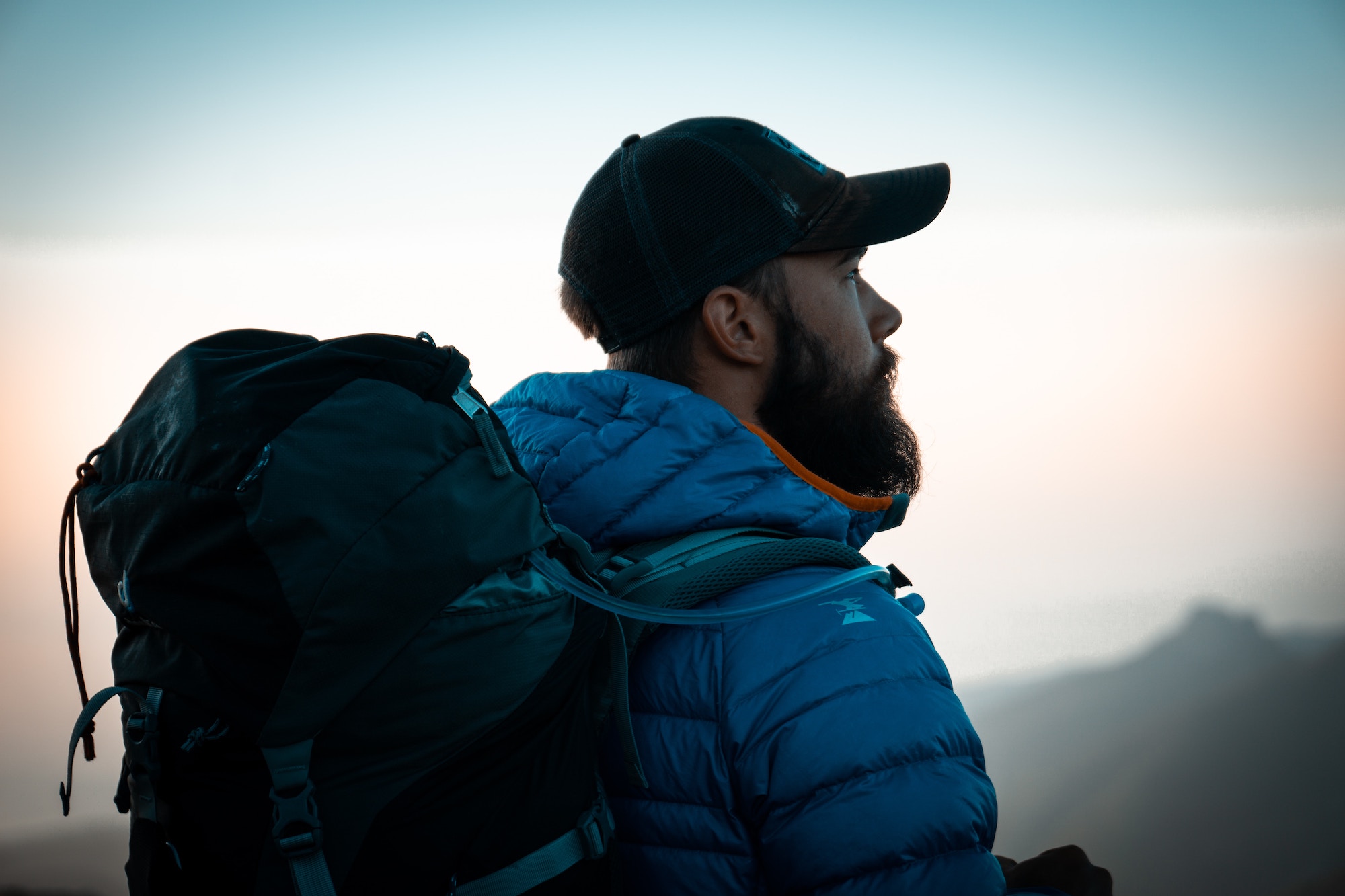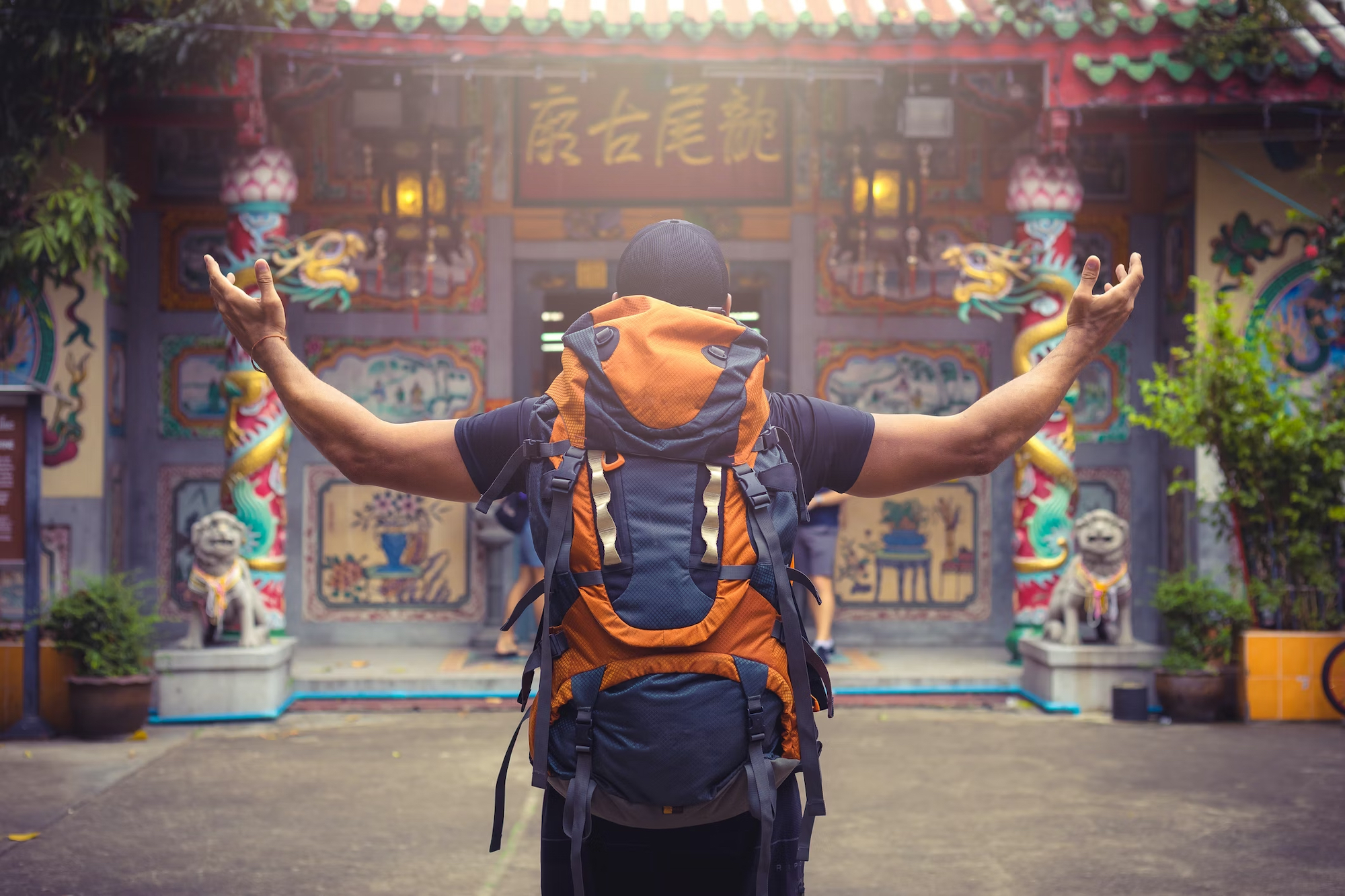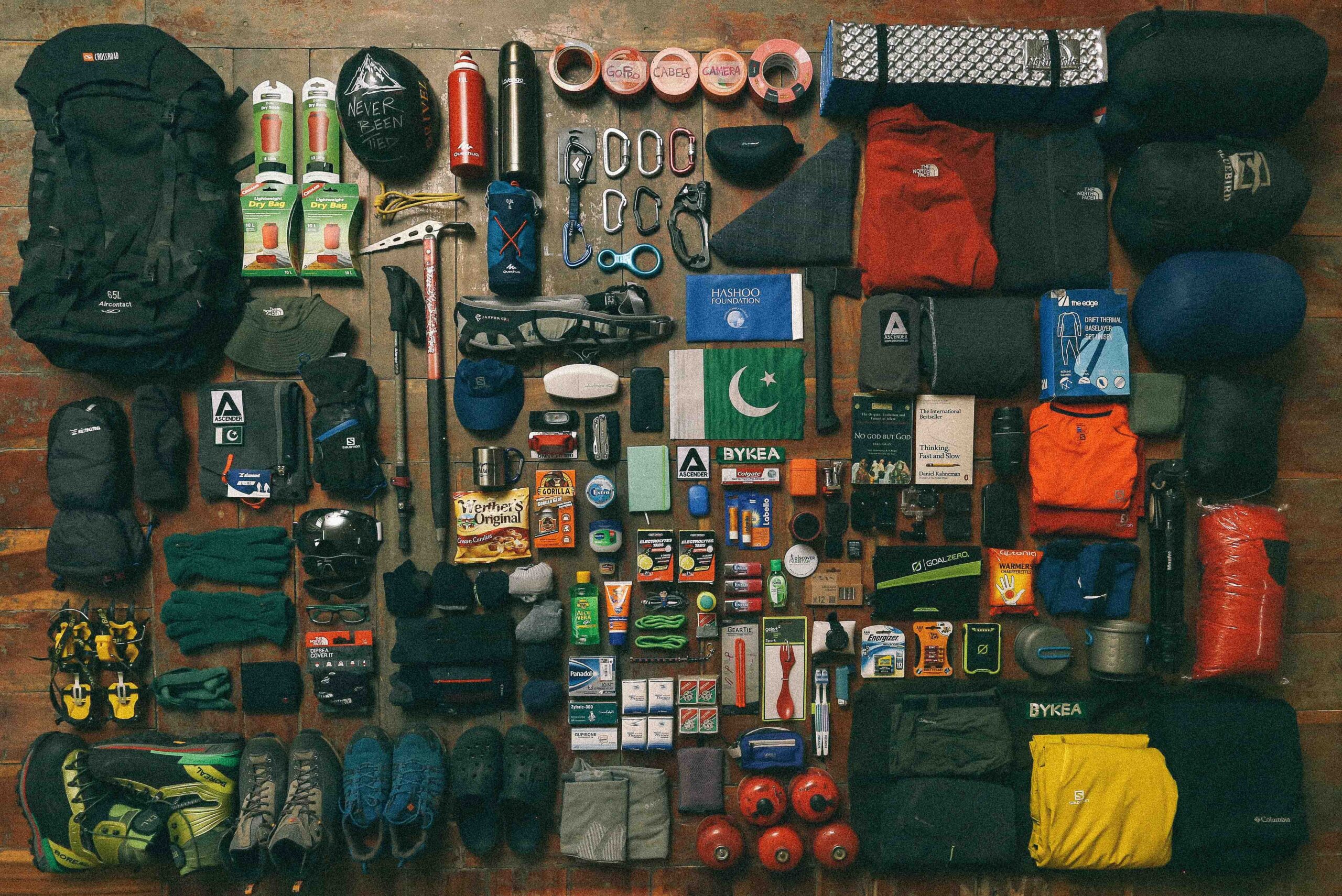Preparing for a backpacking journey in 2024? Whether you’re planning to explore the wilderness or embark on a cultural expedition, packing efficiently is the key to a successful backpacking. This comprehensive guide outlines exactly what to pack for a backpacking trip. We’ll help you make the right choices to ensure your backpack is light yet complete, letting you embrace your backpacking adventure with confidence. We’ll also provide a backpacking packing list that includes all the essentials you will need on your trip. Let’s dive in!
This article contains affiliate links from the Amazon Associate and Travelpayouts programs. Wild Travel Tales will earn from qualifying purchases, at no extra cost to you.
10 Essential Backpacking Items
When you’re embarking on a backpacking adventure, every ounce in your backpack matters. Here, we introduce you to the top 10 essential items that every traveller should consider for their backpacking packing list (beyond your obvious clothing needs). These tried-and-true essentials have been curated from years of backpacking experience to ensure you’re well-prepared for the journey ahead.
- Travel Backpack: Your backpack is your lifeline, the cornerstone of your backpacking experience. It should provide the right balance between capacity and comfort. We recommend a well-designed, durable backpack in the 40-60 litre range for optimal comfort and quality.
- Packing Cubes: Keep your bag organised with compression packing cubes. These make packing efficient and hassle-free, while also ensuring that your clothing stays dry.
- World Travel Adapter: A universal adapter that can fit in different power adapter sizes worldwide, and charge multiple devices. This helps to avoid the stress and confusion of ensuring you have the right plugs.
- Portable Power Bank: There will be moments when you get lost or your transport is delayed. Or your phone may lose charge quickly. A reliable power bank can keep you connected and safe during your backpacking journey.
- Ear plugs: Having comfortable, good quality ear plugs will ensure you can sleep undisturbed in hostels, planes and busses – or even on windy nights in your tent. These are life savers. You will not regret taking a pair.
- Travel Towel: Opt for microfiber travel towels that are compact, quick-drying, and essential for hostel stays. This will save you weight and space compared to traditional towels, which are bulky and slow to dry.
- Combination Padlock: You will need a padlock to secure your bag and belongings in hostel lockers. Protecting your belongings is crucial, especially in shared accommodation.
- Lifestraw: A Lifestraw filter bottle is a powerful tool to make any water source drinkable. Whether you’re drinking from streams, lakes, or puddles or just using tap water in countries where it’s not drinkable, a Lifestraw saves money and the environment by reducing plastic waste. Stay hydrated while reducing your ecological footprint.
- Headlamp: A reliable source of light is essential for safety and convenience, especially when you’re in remote areas or navigating in the dark. Make sure you pack a spare battery!
- First Aid Kit: Accidents can happen anywhere and a well-equipped first aid kit can make a significant difference in an emergency. Ensure it includes bandages, antiseptic wipes, pain relievers, burn cream and tweezers.
Each of these essential items contributes to a successful backpacking adventure by providing comfort, security, and organization. But remember to adapt this list to your specific needs and destination. Travel smart, pack light, and embrace the world with open arms.
Backpacking Packing Tips
Choosing What to Pack
When it comes to backpacking, one of the most critical decisions you’ll make is what to pack. However, there’s no one-size-fits-all answer. What you choose to include in your backpack should be tailored to your specific destination, travel style, and the weather you’ll encounter. In this section, we’ll guide you on adapting your backpacking packing list based on climate considerations and your chosen destination, all while emphasising the importance of lightweight clothing and the art of layering.
- Adapting to your destination: Prioritize your gear based on your travel plans. For example, if you’re backpacking Europe in July, you won’t need extensive warm clothing. Think about the typical climate of your destination.
- Seasonal considerations: Pack according to the weather of your destination. Layering is your best friend, and breathable, moisture-wicking materials are the way to go.
- Travel light: Opt for lightweight clothing. Avoid bulky items like denim jeans and choose hiking pants instead. Even in cold weather, layering is more effective than carrying a heavy jacket.
- Keep it dark: Dark clothing hides stains and can be worn for longer periods. Choose dark shades for practicality.
- Pack fewer clothes: Don’t overpack. You can find clothing for affordable prices in many parts of the world. A minimalist approach is often best.
Keeping Your Pack Light
When it comes to backpacking, there’s a golden rule that can make or break your adventure: pack light. Whether you’re planning to camp in the wilderness or explore the bustling streets of Europe or Asia, the key to a successful journey is traveling as lightly as possible.
Traveling light offers numerous advantages that can greatly enhance your backpacking experience:
- Spare Space: Lighter luggage means more space in your backpack for those unexpected treasures or irresistible souvenirs you pick up along the way. Your backpack isn’t just a practical container; it’s a canvas for the memories and experiences you collect during your journey.
- Less Strain: Heavy bags are a recipe for discomfort and stress. A burdened back and shoulders can quickly turn your adventure into an ordeal. Lightening your load can help ensure your shoulders and back remain in good shape, so you can explore your chosen destination with ease.
Here’s the core principle: aim for a backpack that’s as light as possible. While the ideal weight can vary depending on your gender, generally, ladies should target a pack weight below 10kg, and gentlemen should aim for around 15kg, although getting closer to 10kg is even better. Lighter packs aren’t just about adhering to a number; they make for happier travellers who can fully embrace their journey without the burden of excess weight.
Keep Your Belongings Dry and Organized
Always be ready for any weather. Ensure you consider waterproofing in you backpacking packing list. Invest in a quality rain cover for your backpack and use a dustbin liner to keep your possessions dry. In case of redundancy, avoid putting everything in your backpack. We prefer to distribute technology in our daypacks, passports in neck bags, and copies of important documents in backpacks. A system like this can save your journey when unexpected events occur.

Choosing a Backpack for your Backpacking Adventure
The right backpack is your travel companion. Consider size, quality, comfort, and purpose when selecting your pack.
- Size matters: Choose the size of your backpack based on the length of your trip. A long journey requires a 55-75L pack, while a shorter getaway or hiking trip suits a 40-50L pack. Remember, the more space you have, the more you’ll pack.
- Quality over quantity: Invest in a quality backpack like Osprey, Arc’teryx, or Deuter, which come with a lifetime guarantee. Cheaper brands may offer value, but top-tier backpacks are built to last.
- Comfort equals happy travels: A well-fitting backpack is essential for your comfort during long journeys. Adjustable straps and lightweight materials make a significant difference in how you carry your load.
- Purpose-driven choices: Distinguish between travel packs and hiking packs. Travel packs offer convenience, with features like wheels, handles, and compartments. Hiking packs, on the other hand, focus on functionality and comfort for the trail. Make an informed choice that aligns with your journey’s demands.
Backpacking Clothes Checklist
The key to successful backpacking is to choose the right clothing. Here are some tips to get you started with your backpacking clothes checklist:
- Pack light clothes: Choose clothes that are lightweight, fold up small, and avoid heavy items like denim jeans. Opt for layering to adapt to varying temperatures.
- Dress dark: Dark-colored clothing hides stains and can be worn for longer, a practical choice for backpackers.
- Bring fewer clothes: Rather than overpacking, pack slightly less and purchase any additional items you may need while traveling. This is especially relevant in countries with affordable, locally made clothing.
Your choice of clothing depends on your destination and the nature of your journey. Adapt your backpacking packing list to ensure you’re prepared for any situation. To get you started, here are our top clothing recommendations to cover a wide range of scenarios:
- Underwear (x5): Pack enough for your entire trip, as finding the right fit may be challenging in some regions.
- Hiking trousers (x1): Opt for hiking pants that are comfortable, moisture-wicking, and mosquito-repellent.
- Long-sleeved shirt: Essential in certain areas, these shirts protect you from bugs and harmful sun exposure.
- Travel clothes: Ensure you have 3-4 shirts and shorts to keep you going between washes.
- Wide-brimmed travel hat: Protect yourself from the sun’s rays with a hat.
- Buff: Versatile and useful for various purposes, including sun protection, dust prevention, and eye masking during travel.
- Sunglasses: Invest in durable, high-quality sunglasses, designed to withstand the challenges of travel.
- Warm gear: If your journey takes you to colder climates or mountains, pack essential items like water-resistant gloves, a hat with ear-flaps, a down jacket, and reliable rain gear.
- Flip flops: For comfort and casual strolls, don’t forget a pair of flip flops to keep your feet happy.
- Grippy gloves: Protect your hands in the outdoors with a set of resilient anti-slip gloves, suitable for climbing and handing tools.

Backpacking Hiking Gear Checklist
When it comes to hiking, having the right gear can make all the difference in your experience. Here’s a comprehensive checklist of essential hiking equipment for your backpacking packing list, to ensure you’re well-prepared for your outdoor adventure:
- Sturdy outdoor hiking boots: Your choice of shoes is crucial. Consider the terrain you will be trekking. Ideally, you can opt for something light and nimble, with good ankle support. Rocky and technical trails will require sturdier and heavier shoes.
- Hiking socks: Moisture-wicking, cushioned socks to prevent blisters. Pack some spares, as no one likes wet socks!
- Lightweight, quick-drying clothing: Lightweight and breathable materials to keep you dry and cool.
- Insulating layer: A fleece jacket or down vest to stay warm. This is worthwhile packing even if you expect the weather to be warm. It is always good to be prepared!
- Lightweight, breathable rain jacket: Stay dry in wet conditions with a waterproof jacket.
- Hydration system: Water reservoir or water bottles for staying hydrated.
- Lightweight tent: Minimise your pack weight with a compact, lightweight tent for your overnight camping needs.
- Lightweight sleeping mat: This is essential to keep you comfortable at night.
- Sleeping bag: Ensure you get a sleeping bag with the correct temperature grading.
- Multi-tool or knife: For various tasks.
- Hand sanitizer: Keep hands clean on the trail.
- Toilet trowel: For Leave No Trace practices.
- Collapsible trekking poles: Provide stability and reduce strain.
- Jungle strength insect repellent: Important for bug-prone areas.

Technology Checklist
In today’s world, technology can greatly enhance your backpacking experience, from staying connected to capturing unforgettable moments. Here’s a guide to essential tech gear to add to your backpacking packing list:
- Smartphone: Your smartphone is a multi-tool for navigation, communication, photography, and more. Choose a rugged, waterproof model with a good camera and long battery life. You should also research the best international SIM cards (we recommend an international eSIM for convenience).
- Noise-canceling headphones: Noise-canceling headphones provide a peaceful oasis during long journeys, flights, or noisy hostel dorms. Ensure your headphones have extended battery life for those long travel days.
- Universal power adapter: Different countries have different power outlets. A universal adapter ensures your devices can be charged worldwide. Look for an adapter that covers a wide range of plug types and voltages.
- Portable solar charger: Keeping your devices charged is vital, especially in remote locations where power outlets are scarce. A portable solar charger harnesses the sun’s energy to charge your gadgets.
- Power bank: When you get lost, transport is delayed or your phone drains battery more quickly than expected, a power bank is your backup plan. It can recharge your devices multiple times. Get a power bank with sufficient capacity to charge your devices fully 3+ times.
- Lightweight laptop or tablet: This can be useful for planning your travels, work, entertainment, or simply keeping a journal. Look for a model with a compact design, solid battery life, and a responsive touchscreen or keyboard.
- eReader: Save space and weight by bringing along an eReader. It’s perfect for bookworms and can store countless books in one device.
Safety Essentials
Safety should always be a top priority when backpacking in remote or challenging environments. Here are essential items for your safety.
First Aid Kit
Carrying a equipped and compact first aid kit can be a lifesaver in emergencies. Ensure your kit includes:
- Band-Aids: Various sizes for covering minor cuts and blisters.
- Antiseptic wipes: To clean wounds and prevent infections.
- Gauze and tape: For dressing larger wounds.
- Tweezers: Useful for splinter removal.
- Pain relievers: Such as ibuprofen or aspirin.
- Personal medications: Carry any necessary prescription medications.
- Emergency contact information: Include emergency contact numbers and medical information.
Having a first aid kit can provide peace of mind and essential care when needed during your journey.
Navigation Tools
Proper navigation tools and skills are crucial for staying on the right path during your backpacking adventure. Consider the following:
- Map: Bring detailed topographic maps of the area you’ll be exploring. Waterproof maps are a great choice.
- Compass: A reliable compass helps you orient yourself and find your bearings.
- GPS device: While not a substitute for a map and compass, a GPS device can provide additional navigation assistance.
- Trail guides: Research and obtain trail guides or apps for your specific route.
Having the means to navigate effectively can prevent you from getting lost and ensure you reach your destinations as planned.
Emergency Shelter
Unforeseen circumstances can sometimes leave you exposed to the elements. Packing emergency shelter options can be a lifesaver:
- Emergency blanket: These compact, lightweight shelters provide insulation and protection from the cold.
- Tarp or poncho: A versatile tarp or poncho can be used to create improvised shelter.
- Emergency tent: Consider an ultra-light tent if you expect to be in areas where sudden storms are common.
Carrying an emergency shelter ensures you have a safe place to wait out bad weather or unexpected situations.
Headlamp
A reliable headlamp is essential for providing illumination during nighttime or low-light conditions. This will be essential during activities like cooking, reading, navigating, and handling emergencies in the dark. Look for features like adjustable brightness, long battery life, water resistance and red-light mode.
Essential Kitchen Gear
Your backpacking kitchen is where the magic happens, and having the right gear is essential. This section will dive into the importance of a camp stove, considerations when choosing one, the significance of cookware, and the various options for water purification. Here are some items to consider for your portable kitchen and add to your backpacking packing list:
Camp Stove
A reliable lightweight camp stove is a must for cooking meals on the trail. Look for the following features:
- Portability: Choose a lightweight and compact stove that won’t take up too much space in your backpack.
- Fuel source: Consider the type of fuel the stove uses. Some options include canister stoves, liquid fuel stoves, and wood-burning stoves.
- Boil time: Check the stove’s efficiency in boiling water quickly, as this can save you time and fuel.
- Simmer control: Having the ability to simmer your meals is a plus for gourmet backpacking cooking.
- Windscreen: A built-in or add-on windscreen helps protect the flame from wind, ensuring efficient cooking.
Cookware
Selecting the right cookware can make a significant difference in your culinary endeavors while backpacking. Consider these options:
- Lightweight pots and pans: Opt for pots and pans made from lightweight materials like titanium or aluminium.
- Non-stick coating: Non-stick surfaces make cooking and cleaning easier.
- Lids and handles: Look for cookware with secure lids and foldable or removable handles for compact storage.
- Nested sets: Some cookware sets are designed to nest together, saving space in your backpack.
Having a well-equipped kitchen can elevate your backpacking meals from basic to gourmet, enhancing your overall experience.
Water Purification
Access to clean drinking water is crucial for staying hydrated and healthy during your backpacking journey. Here are options for water purification:
- Portable water purification filter: Portable water filters allow you to drink directly from streams and rivers by removing bacteria and protozoa.
- Water purification tablets: These small tablets can be added to your water to kill harmful microorganisms.
- UV steriliser: UV pens or lights are effective at sterilising water and killing bacteria, viruses, and protozoa.
- Boiling: Boiling water for at least one minute is a reliable way to purify it. Ensure you have a heat-resistant container for this method.
Having a dependable water purification method ensures you have a safe and clean water supply throughout your backpacking adventure.
Portable Utensils
Eating on the trail requires lightweight and portable utensils. Consider the following:
- Spork: A combination of a spoon and fork is a versatile and compact utensil.
- Collapsible bowl and mug: These items save space and can be used for both eating and drinking.
- Knife: A small, sharp knife is useful for food preparation and various tasks.
- Cleaning supplies: Don’t forget a small sponge or cleaning pad to wash your utensils.
Having the right kitchen gear allows you to prepare delicious meals and enjoy a more comfortable dining experience while backpacking.

Toiletries Packing List
When you’re out in the great outdoors, maintaining your personal hygiene can be a bit of a challenge. That’s where a well-thought-out toiletries packing list comes in. Here’s a comprehensive checklist of essential toiletries to keep you feeling fresh and clean during your hiking adventure:
Basic Toiletries
- Toothbrush and toothpaste: Keep your dental hygiene in check.
- Soap: Biodegradable soap for body and hands.
- Hand sanitizer: An essential for maintaining hand hygiene.
- Microfibre towel: A compact, microfibre travel towel is a must-have for backpackers. Traditional towels are bulky and slow to dry, whereas travel towels are compact, lightweight, and quick-drying.
Hair and Skin Care Products
- Shampoo and conditioner: Travel-sized bottles.
- Hairbrush or comb: Keep your hair tangle-free.
- Sunscreen: Protect your skin from harmful UV rays.
- Moisturizer: Wind, cold temperatures and lack of humidity will make your skin very dry.
- Lip balm: No one likes cracked lips!
Personal care
- Toilet paper: Pack it in a ziplock bag to keep it dry. You will almost definitely need it at some point.
- Menstrual products: If needed.
Extras
- Insect repellent: Ward off pesky bugs.
- Nail clippers: Keep those nails in check.
Maintaining personal hygiene while hiking is not only about comfort but also about responsible outdoor ethics. A well-organised toiletries backpacking packing list ensures you stay fresh, while minimising your impact on the environment. So, pack your essentials, be mindful of the wilderness, and enjoy your hiking adventure to the fullest.
Documents Checklist
Before embarking on your hiking journey, make sure you have all the necessary documents in order. This will help support a smooth backpacking journey. Here’s a checklist of essential paperwork and identification you should add to your backpacking packing list.
Identification
- Passport: Check its expiration date. You may also want to carry a photocopy in a separate location.
- Visas: If required for the countries you’re visiting.
- Driver’s license: Useful for renting a car or for identification purposes.
Travel Insurance
- Travel insurance policy: Keep a copy of your policy details, including the emergency contact number.
- Health insurance card: Carry your health insurance card for medical emergencies.
Itineraries and Reservations
- Flight tickets: Both the physical ticket and electronic copies.
- Hotel reservations: Print or save confirmations.
- Hiking permits: If needed for your hiking destination.
Money and Finance
- Credit/debit cards: Notify your bank of your travel plans to avoid any issues.
- Cash: Carry some local currency in small denominations.
Maps and Guidebooks
- Hiking maps and guides: Helpful for navigation. Download the maps.me app for detailed offline trail maps.
Having the right documents at your disposal ensures a smooth and worry-free hiking adventure. Double-check this essential documents checklist before you hit the trail to make the most of your outdoor experience.
Conclusion
As we conclude this comprehensive backpacking packing guide, we’ll reiterate the importance of considering what items are needed for your specific trip. This article merely provides a list to get you thinking about the items that could be useful in different circumstances. Understanding what to pack for a backpacking trip is essential to ensure you have the right gear, that you have backed efficiently and that you are well-prepared for both safety and comfort.
FAQs
Essential items for backpackers typically include a travel backpack, daypack, travel towel, travel security belt, combination padlock, world travel adapter, packing cubes, travel-friendly laptop, toiletry bag, and a reliable action camera.
For a 3-month backpacking trip, pack essential clothing, toiletries, a compact first aid kit, necessary travel documents, lightweight camping and cooking gear, and versatile items for a range of weather conditions. Focus on versatile clothing to mix and match.
The recommended backpack weight for a comfortable backpacking experience is around 10-15% of your body weight. For example, if your weight is 68 kilograms (150 pounds), aim to carry a backpack that weighs 6.8-10.8 kilograms (15-22.5 pounds).
The size of the backpack you need for backpacking depends on your specific gear and trip requirements. A 40-60 liter backpack is typically sufficient for most backpackers, but it may vary based on the duration and nature of your journey.
A 50L backpack can be sufficient for backpacking, especially if you pack efficiently and focus on the essentials. However, the size you need depends on the nature and duration of your trip.
A 70L backpack may be too large for travel, as it can lead to over-packing and a heavier load. Consider a smaller backpack unless you have specific gear or equipment requirements for your journey.
To fit a week’s worth of clothes in a backpack, prioritise lightweight and versatile clothing. Roll or use compression bags for packing, and consider packing multi-purpose items that can be worn in various combinations. This is the best way to trim down your backpacking packing list.
Avoid bringing unnecessary items like heavy, bulky clothing, excessive gadgets, and items that can be easily purchased on the road. Minimize toiletries and non-essential accessories.
